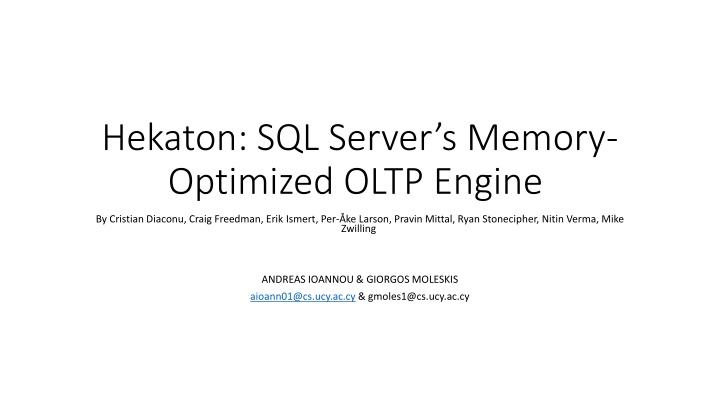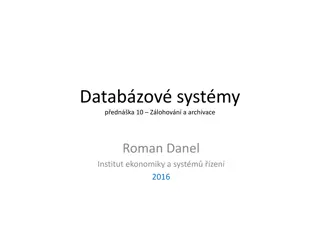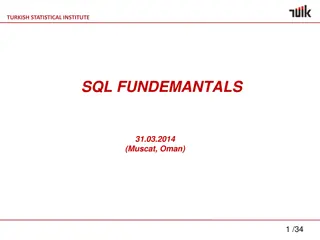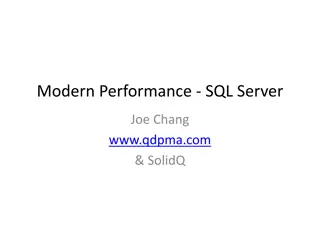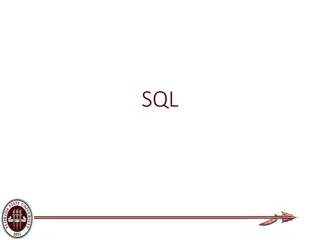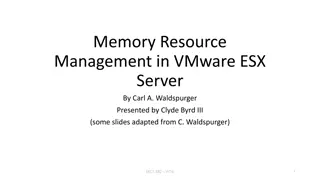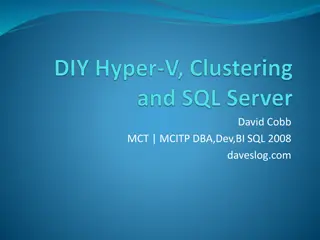Hekaton: SQL Server's Memory-Optimized OLTP Engine Overview
This overview introduces Hekaton, a database engine optimized for memory-resident data and OLTP workloads. Integrated into SQL Server, it discusses the design principles, architecture, storage mechanisms, transaction management, and concurrency control of this innovative engine.
Download Presentation

Please find below an Image/Link to download the presentation.
The content on the website is provided AS IS for your information and personal use only. It may not be sold, licensed, or shared on other websites without obtaining consent from the author.If you encounter any issues during the download, it is possible that the publisher has removed the file from their server.
You are allowed to download the files provided on this website for personal or commercial use, subject to the condition that they are used lawfully. All files are the property of their respective owners.
The content on the website is provided AS IS for your information and personal use only. It may not be sold, licensed, or shared on other websites without obtaining consent from the author.
E N D
Presentation Transcript
Hekaton: SQL Servers Memory- Optimized OLTP Engine By Cristian Diaconu, Craig Freedman, Erik Ismert, Per- ke Larson, Pravin Mittal, Ryan Stonecipher, Nitin Verma, Mike Zwilling ANDREAS IOANNOU & GIORGOS MOLESKIS aioann01@cs.ucy.ac.cy & gmoles1@cs.ucy.ac.cy
OVERVIEW Introduction Principles behind the design of the engine. High-level overview of the architecture. How data is stored, indexed, and updated. How stored procedures and table definitions are compiled into native code. Transaction management and concurrency control How transaction durability is ensured. Garbage collection Some experimental results.
What is Hekaton ? Is a new database engine optimized for memory resident data and OLTP workloads. Fully integrated into SQL Server. How to use? Simply declare a table memory optimized.
INTRODUCTION The most database management systems were designed assuming that main memory is expensive and data resides on disk. This assumption is no longer valid. Memory prices have dropped by a factor of 10 every 5 years. The majority of OLTP databases fit entirely in 1TB The largest OLTP databases can keep the active working set in memory.
Advantage of being Integrated into SQL Avoid the hassle and expense of another DBMS. Only the most performance-critical tables need to be in main memory, other tables can be left unchanged. Stored procedures accessing only Hekaton tables can be compiled into native machine code for further performance gains. Conversion can be done gradually, one table and one stored procedure at a time.
Memory optimized tables Managed by Hekaton and stored entirely in main memory Are fully durable and transactional, though non-durable tables are also supported. Can be queried and updated using T-SQL in the same way as regular SQL Server tables. A query can reference both Hekaton tables and regular tables and a single transaction can update both types of tables. T-SQL stored procedure that references only Hekaton tables can be compiled into native machine code(fastest way to query and modify data)
Concurrency Does not rely on partitioning to achieve this Any thread can access any row in a table without acquiring latches or locks. The engine uses: Latch-free (lock-free) data structures to avoid physical interference among threads Optimistic Multiversion concurrency control technique to avoid interference among transactions
DESIGN CONSIDERATIONS Throughput can be increased in three ways: 1. Improving scalability 2. Improving CPI (cycles per instruction) 3. Reducing the number of instructions executed per request Even under highly optimistic assumptions, improving scalability and CPI can produce only a 3-4X improvement. Reduce the number of instructions executed To go 10X faster, the engine must execute 90% fewer instructions and yet still get the work done. To go 100X faster, it must execute 99% fewer instructions. This level of improvement is not feasible by optimizing existing storage and execution mechanisms. Reaching the 10- 100X goal requires a much more efficient way to store and process data
Architectural Principles Optimize indexes for main memory Current mainstream database systems use disk-oriented storage structures Records are stored on disk pages that are brought into memory Complex buffer pool A page must be protected by latching before it can be accessed A simple key lookup in a B-tree index may require thousands of instructions even when all pages are in memory. Hekaton indexes are designed and optimized for memory-resident data Durability is ensured with Logging Checkpoints During recovery Hekaton tables and their indexes are rebuilt entirely from the latest checkpoint and logs.
Architectural Principles Eliminate latches and locks Scalability suffers when the systems has shared memory locations that are updated at high rate Latches, spinlocks Highly contended resources(lock manager, the tail of the transaction log,B-tree index) All Hekaton s internal data structures are entirely latch-free (lock-free). Indexes Transaction map Hekaton uses a new optimistic multiversion concurrency control to provide transaction isolation semantics(no locks and no lock table) System where threads execute without stalling or waiting.
Architectural Principles Compile requests to native code SQL Server uses interpreter based execution mechanisms in the same ways as most traditional DBMSs Great flexibility but at a high cost Even a simple transaction performing a few lookups may require several hundred thousand instructions. Hekaton converts statements and stored procedures from T-SQL to machine code The generated code contains exactly what is needed to execute the request At compile time makes decisions to reduce runtime overhead
Architectural Principles No Partitioning Recent systems designed for OLTP workloads and memory resident data Partition the database by core One exclusive core for each partition Partitioning can be expensive if a transaction needs access to several partitions Hekaton does not partition the database Any thread can access any part of the database
HIGH-LEVEL ARCHITECTURE Storage engine manages User data and Indexes Transactional operations on tables of records, hash and range indexes Base mechanisms for storage, checkpointing, recovery and high-availability Hekaton compiler Compiles the procedure into native code designed to execute against tables and indexes managed by the Hekaton storage engine. Hekaton runtime system provides integration with SQL Server resources and serves as a common library of additional functionality
Metadata Metadata about Hekaton tables, indexes are stored in the SQL Server catalog Query optimization Queries embedded in compiled stored procedures are optimized using the regular SQL Server optimizer Query interop Operators for accessing data in Hekaton tables Transactions can access and update data both in regular tables and Hekaton tables High availability: AlwaysOn, SQL Server s high availability feature Storage, log: Hekaton logs its updates to the regular SQL Server transaction log
STORAGE AND INDEXING A table created with the new option memory_optimized is managed by Hekaton and stored entirely in memory. Hekaton can have several indexes and supports two types of indexes: hash indexes implemented using lock-free hash tables range indexes implemented using Bw-trees, a novel lock-free version of B-trees Hekaton uses multiversioning an update always creates a new version.
STORAGE AND INDEXING Record Format Hash Index on name Ordered index on city Reads At most one version of a record is visible to a read Records returns with valid times (Ex. 10 20) Non-overlapping valid times Updates When updating change Header End to current time Current time shows the next record that could be valid Header end = inf is always the latest record valid We can't update obsolete versions A version can be discarded when it is no longer visible to any active transaction.
PROGRAMMABILITY AND QUERY PROCESSING Hekaton maximizes run time performance by converting SQL statements and stored procedures into highly customized native code. Compile once-and-execute-many-times Reuse much of the SQL Server T-SQL compilation stack including the metadata, parser, name resolution, type derivation, and query optimizer. The output of the Hekaton compiler is C code and with Microsoft s Visual C/C++ compiler to convert the C code into machine code.
PROGRAMMABILITY AND QUERY PROCESSING Architecture of the Hekaton compiler There are two main points where we invoke the compiler: Creation of a memory optimized table Creation of a compiled stored procedure. MAT ( mixed abstract tree ) Tree capable of representing metadata, imperative logic, expressions, and query plans. PIT(pure imperative tree) Data structure which is a much simpler data structure that can be easily converted to C code
PROGRAMMABILITY AND QUERY PROCESSING Schema Compilation Table creation requires code generation Hekaton storage engine treats records as opaque objects. No knowledge of Internal content or format of records Cannot directly access or process the data in records The Hekaton compiler provides the engine with customized callback functions for each table: Computes hash function on a key or record Comparing two records Serializing a record into a log buffer These functions are compiled into native code Inserts and searches are extremely efficient
PROGRAMMABILITY AND QUERY PROCESSING Compiled Stored Procedures Challenges Transformation of query plans into C code T-SQL and C type systems and expression semantics are very different T-SQL includes many data types such as date/time types and fixed precision numeric types that have no corresponding C data types. In addition, T-SQL supports NULLs while C does not. Finally, T-SQL raises errors for arithmetic expression evaluation failures such as overflow and division by zero while C either silently returns a wrong result or throws an OS exception that must be translated into an appropriate T-SQL error. Solution Intermediate step Converting the MAT into the PIT Convert PIT to C code.
PROGRAMMABILITY AND QUERY PROCESSING Compiled Stored Procedures Interface consists of get first, get next, return row, and return done. Without functions. Result in wasted instructions where one operator merely calls another without performing any useful work. Collapse an entire query plan into a single function Use labels and gotos to implement and connect these interfaces.
PROGRAMMABILITY AND QUERY PROCESSING Compiled Stored Procedures Single function design Fewest number of instructions executed Smallest overall binary Using gotos The code always grows linearly with the number of operators There are cases where it does not make sense to generate custom code Sort operator generic sort implementation with a callback function to compare records Complex or expensive functions include them in a library and call them from the generated code
PROGRAMMABILITY AND QUERY PROCESSING Restrictions Hekaton Support SELECT, INSERT, UPDATE, and DELETE Queries currently can include inner joins, sort and top sort, and basic scalar and group by aggregation. Limitations of compiled stored procedures Support a limited set of options Controlled at compile time only Eliminates unnecessary run time checks. Execute in a predefined security context so that we can run all permission checks once at creation time. Schema bound Tables referenced by that procedure cannot be dropped without first dropping the procedure This avoids costly schema stability locks before execution Fourth, compiled stored procedures must execute in the context of a single transaction. This requirement ensures that a procedure does not block midway through to wait for commit.
Query Interop Mechanism that enables the conventional query execution engine to access memory optimized tables Import and export of data to and from memory optimized tables Using the existing tools and processes that already work for regular tables. Execute virtually any legal SQL query against memory optimized tables Use features such as views and cursors that are not supported in compiled stored procedures. Support for transactions that access both memory optimized and regular tables. Ease of app migration. Existing tables can be converted to memory optimized tables without extensive work Convert existing stored procedures into compiled stored procedures.
TRANSACTION MANAGEMENT Hekaton utilizes optimistic multiversion concurrency control (MVCC) to provide snapshot, repeatable read and serializable transaction isolation without locking To ensure that a transaction T is serializable we must ensure that the following two properties hold. Read stability. T reads some version V1 Must ensure that V1 is still the version visible to T as of the end of the transaction. Implemented by validating that V1 has not been updated before T commits. Phantom avoidance. Must ensure that the transaction s scans would not return additional new versions. Implemented by rescanning to check for new versions before commit.
TRANSACTION MANAGEMENT Timestamps and Version Visibility Timestamps produced by a monotonically increasing counter are used to specify the following. Logical Read Time the read time of a transaction can be any value between the transaction s begin time and the current time. Commit/End Time for a transaction: every transaction that modifies data commits at a distinct point in time called the commit or end timestamp of the transaction Valid Time for a version of a record: The begin timestamp denotes the commit time of the transaction that created the version and the end timestamp denotes the commit timestamp of the transaction that deleted the version A transaction executing with logical read time RT must only see versions whose begin timestamp is less than RT and whose end timestamp is greater than RT. A transaction must see its own updates.
TRANSACTION MANAGEMENT Transaction Commit Processing Validation and Dependencies At the time of commit, a serializable transaction must verify that: The versions it read have not been updated No phantoms have appeared. The validation phase begins with the transaction obtaining an end timestamp. This end timestamp determines the position of the transaction within the transaction serialization history. To validate its reads Transaction checks that the versions it read are visible as of the transaction s end time. To check for phantoms It repeats all its index scans looking for versions that have become visible since the transaction began To enable validation each transaction maintains a read set, a list of pointers to the versions it has read, and a scan set containing information needed to repeat scans.
TRANSACTION MANAGEMENT Transaction Commit Processing If the validation succeeds The transaction is likely to commit Its effects must be respected by all other transactions in the system as if they occurred atomically as of the end timestamp. If validation fails Nothing done by the transaction must be visible to any other transaction. How Hekaton preserve the non-blocking nature Commit dependency T1 take a commit dependency on T2. This means that T1 is allowed to commit only if T2 commits. If T2 aborts, T1 must also abort so cascading aborts are possible.
TRANSACTION MANAGEMENT Transaction Commit Processing Commit dependencies introduce two problems: A transaction cannot commit until every transaction upon which it is dependent has committed Commit dependencies imply working with uncommitted data and such data should not be exposed to users. Solution: Read barriers. This simply means that a transaction s result set is held back and not delivered to the client while the transaction has outstanding commit dependencies. The results are sent as soon as the dependencies have cleared.
Transaction Commit Processing Commit Logging and Post-processing Committed as soon as its changes to the database have been hardened to the transaction log. Irreversibly committed Post-processing phase Update begin and end timestamps in all versions affected by the transaction to contain the end timestamp of the transaction. Transactions maintain a write-set, a set of pointers to all inserted and deleted versions that is used to perform the timestamp updates and generate the log content.
Transaction Commit Processing Transaction Rollback Transactions can be rolled back at User request Due to failures in commit processing Rollback is achieved by invalidating all versions created by the transaction and clearing the end-timestamp field of all versions deleted by the transaction.
TRANSACTION DURABILITY Transaction logs to durable storage Checkpoints to durable storage. Log streams contain the effects of committed transactions logged as insertion and deletion of row versions. Checkpoint streams come in two forms: Data streams which contain all inserted versions during a timestamp interval Delta streams, each of which is associated with a particular data stream and contains a dense list of integers identifying deleted versions for its corresponding data stream.
Transaction Logging Each transaction is logged in a single, potentially large, log record. The log record contains information about all versions inserted and deleted by the transaction, sufficient to redo them. Dirty data is never written to durable storage. Hekaton tries to group multiple log records into one large I/O Multiple log streams can be used because serialization order is determined solely by transaction end timestamps and not by ordering in the transaction log
Checkpoints The checkpointing scheme is designed to satisfy two important requirements. Continuous checkpointing. Checkpoint related I/O occurs incrementally and continuously as transactional activity accumulates. Streaming I/O. Checkpointing relies on streaming I/O rather than random I/O for most of its operations. Even on SSD devices random I/O is slower than sequential and can incur more CPU overhead due to smaller individual I/O requests.
Checkpoint Files Checkpoint data is stored in two types of checkpoint files: Data files Contains only inserted versions (generated by inserts and updates) covering a specific timestamp range Are append-only while opened and once closed, they are strictly read-only Delta files. Stores information about which versions contained in a data file have been subsequently deleted Are append-only for the lifetime of the data file they correspond to. At recovery time, is used as a filter to avoid reloading deleted versions into memory. A complete checkpoint consists of multiple data and delta files and a checkpoint file inventory that lists the files comprising the checkpoint. There is a 1:1 correspondence between a delta file and a data file. A checkpoint file inventory tracks references to all the data and delta files that make up a complete checkpoint. The inventory is stored in a system table.
Checkpoint Process Checkpoint Process A checkpoint task takes a section of the transaction log not covered by a previous checkpoint and converts the log contents into one or more data files and updates to delta files. New versions are appended to either the most recent data file or into a new data file and the IDs of deleted versions are appended to the delta files corresponding to where the original inserted versions are stored. Once the checkpoint task finishes processing the log, the checkpoint is completed with the following steps. Flush all buffered writes to the data and delta files and wait for them to complete. Construct a checkpoint inventory that includes all files from the previous checkpoint plus any files added by this checkpoint. Harden the inventory to durable storage. Store the location of the inventory in a durable location available at recovery time. We record it both in the SQL Server log and the root page of the database.
Checkpoints Since crash recovery will read the contents of all data and delta files in the checkpoint, performance of crash recovery degrades as the utility of each data file drops. The solution to this problem is to merge temporally adjacent data files when their active content (the percentage of undeleted versions in a data file) drops below a threshold. Merging two data files DF1 and DF2 results in a new data file DF3 covering the combined range of DF1 and DF2. All deleted versions, that is, versions identified in the DF1 and DF2 s delta files, are dropped during the merge. The delta file for DF3 is empty immediately after the merge.
Checkpoints Recovery Hekaton recovery starts after the location of the most recent checkpoint inventory has been recovered during a scan of the tail of the log Hekaton recovery itself is parallelized Each delta file represents in effect a filter for rows that need not be loaded from the corresponding data file This data/delta file pair arrangement means that checkpoint load can proceed in parallel across multiple IO streams at file pair granularity. Creates one thread per core to handle parallel insertion of the data produced by the I/O streams The choice of one thread per core means that the load process is performed as efficiently as possible.
GARBAGE COLLECTION Garbage collection Poor performance Lengthy pause times Blocking Other scaling problems often seen in the virtual machines for managed languages Hekaton avoids these problems. In Hekaton, garbage is defined by a version's "visibility" A version of a record is garbage if it is no longer visible to any active transaction.
GARBAGE COLLECTION The design of the Hekaton garbage collection (GC) subsystem has the following desirable properties. Hekaton GC is non-blocking. Garbage collection runs concurrently with the regular transaction workload The GC subsystem is cooperative. Worker threads running the transaction workload can remove garbage when they encounter it Processing is incremental. Garbage collection may easily be throttled and can be started and stopped to avoid consuming excessive CPU resources. Garbage collection is parallelizable and scalable. Multiple threads can work in parallel on various phases of garbage collection
Garbage Collection Details GC Correctness A version becomes garbage It was deleted (via explicit DELETE or through an UPDATE operation) nd timestamp < oldest active transaction More precisely, the versions deleted or updated by T can be garbage collected because they are invisible to all current and future transactions. Less common way for versions to become garbage is if they were created by a transaction that subsequently rolls back.
Garbage Removal Garbage Removal First be unlinked from all indexes in which it participates. Regular index scanners encounter garbage versions as they scan indexes Unlink garbage versions when they encounter them. Parallelizes garbage collection in the system No extra work to locate garbage versions Sold versions will not slow down future scanners However, this process is insufficient to ensure that either 'Cold' areas of an index which are not traversed by scanners are free of garbage A garbage version is removed from other indexes that it might participate in These versions do not need to be collected for performance reasons They needlessly consume memory and, as such, should be removed as promptly as possible. Offloaded to a background GC process (not critical)
GARBAGE COLLECTION If GC finds a version that is still linked in one or more indexes, it cannot immediately unlink the version since it has no information about the row's predecessor. In order to remove such versions: GC first scans the appropriate part of each index Unlinks the version, after which it can be removed. While scanning, it of course unlinks any other garbage versions encountered.
GARBAGE COLLECTION - Scalability Early versions of the Hekaton GC used a fixed set of threads for collection It was difficult to ensure that a single GC thread could maintain the necessary rate of collection for a high number of incoming transactions, especially for those workloads that were more update/delete heavy. In order to address this problem, the garbage collection has been parallelized across all worker threads in the system. Periodically recalculating the oldest transaction watermark and partitioning completed transactions accordingly. However, once this work has been done, transactions that are ready for collection are then distributed to a set of work queues. This serves two scalability benefits. First, it naturally parallelizes the work across CPU cores, without the additional overhead and complexity of maintaining dedicated worker threads, and second, it allows the system to self-throttle. By ensuring that each thread in the system that is responsible for user work is also responsible for GC work, and by preventing a user thread from accepting more transactional work until a bit of garbage has been collected, this scheme introduces a small delay in the processing of transactions in the system, making sure that the system does not generate more garbage versions than the GC subsystem can retire.
EXPERIMENTAL RESULTS - CPU Efficiency Experiments on workstation with: 2.67GHz Intel Xeon W3520 processor 6 GB of memory An 8 MB L2 cache. Experiment Schema: (c1 int, c2 int, c3 varchar(32)), each containing 1M rows. Column c1 is the primary key Two identical tables, T1 and T2 T1 was a Hekaton table with a hash index on c1 T2 was a regular table with a B-tree index on c1. Both tables resided entirely in memory.
EXPERIMENTAL RESULTS Lookup Efficiency T-SQL procedure RandomLookups that does N random lookups (RAND()) on the primary key (column c1) and computes the average, min, and max of column c2. The driver calls RandomLookups (procedure) in a loop and computes the average CPU cycles consumed per call. The speedup is 20X when doing 10 or more lookups per call. Expressed differently, the Hekaton engine completed the same work using 5% of the CPU cycles used by the regular SQL Server engine.
EXPERIMENTAL RESULTS Update Efficiency TSQL procedure RandomUpdates that updates the c2 column of N randomly selected rows. To measure CPU efficiency and not transaction latency, Enabled write caching on the disk used for the transaction log. The speedup is even higher than for lookups, reaching around 30X for transactions updating 100 or more records. Even for transactions consisting of a single updated, the speedup was around 20X. Hekaton got the work done using between 3% and 5% of the cycles used by the regular engine.
